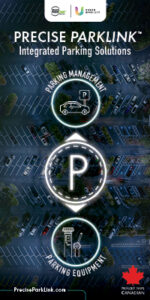Accessible Parking Enhancements: The New Frontier
By Patricia Kierans, MA Candidate in Critical Disability Studies, York University
We have all seen cars cruising around and around parking lots, looking for the ‘sweet spot’ parking space that will get them closest to their destination. And for accessible parking spots, this pressure is only magnified. The Ontario Building Code (OBC) only requires a minimum of one accessible parking space per every one hundred1. With the number of people with disabilities, and accessibility parking permits, increasing every year, how will parking lot owners rise to the challenge of increased demand for accessible parking?
The percentage of people with disabilities in Canada is increasing at a faster rate than the growth of the general population. Today, approximately 14% of Canadians have a disability that impacts their daily activities, with 80% of those report use of an accessibility aid2. In 2011, Human Resources and Skills Development Canada predicted the annual population growth from 2006 through 2036 would be ~1.3% per year, but the number of people with disabilities will increase by ~2.5% per year3.
The exact concentration of people with disabilities impacting mobility varies greatly across the country. People with disabilities, when possible, migrate toward urban areas seeking better access to specialized medical care, social services, and accessible public transit and buildings. Consequently, urban regions are predicting a major increase in the percentage of people with disabilities. The Peel Region of Ontario, including Brampton, has predicted a general population increase of 38% between 2001 and 2021, but an increase of 75% in the number of people with disabilities4.
While each province within Canada has differing requirements for the percentage of accessible parking spaces required for any parking facility, the ratio of accessible parking spots to regular spots remains extremely low. While all parking lots in Ontario adhere to the OBC’s minimum 1 space per 100i, some parking lots offer a greater number of spots, according to Facility Accessibility Design Standards (FADS) developed by the City of London, Ontario5. FADS proposes a dynamic curve: 1 accessible space per 2-4 regular spaces, 4 accessible per 76-100 regular spaces, and 2% of the total for lots between 501 and 1,000 spacesv. The latter is a “Best Practice”: not required legally, but a sound business practice that promotes accessibility. Such a policy not only pre-empts future overwhelming demand, but positively impacts a parking lot’s reputation and improves access to nearby businesses. Enhanced access will encourage repeat parkers, and word-of-mouth will lead to new customers using the parking lot and patronizing nearby businesses.
A crucial question to parking lot owners will centre around the economic argument: as each accessible parking spot has larger dimensions than a standard spot, can the loss of a few standard spots be recouped with accessible parking spots? My contention is yes, and my research has pointed to the reverse situation: instead of causing a net loss of profits, these additional accessible parking spots will be full, and lead to increased general use of the parking lot, through recommendations passed on by people impressed by increased accessibility.
In the UK, the Extra Costs Commission (ECC) was set up in 2015 to examine the financial situation of people with disabilities, and how this affects their interaction with businesses6. It reported that 75% of disabled people and their families left a shop that was not accessible without purchasing anything, and rated good accessibility (55%) as the key factor when deciding where to shop6. With buying power of £212 billion pounds per year, there is every reason for businesses to make accessibility a core principle of their corporate ethos6.
In Canada, a similar situation exists: people with disabilities are often supported by their families, who offer time and assistance free of charge. The Martin Prosperity Institute published “Releasing Constraints: Projecting the Economic Impacts of Increased Accessibility in Ontario” in 2010, and stated that “enabling increased workforce participation among persons with disabilities (PwD) will not only increase their individual and family income, but it could
also increase the GDP per capita in Ontario by up to $600 per person per annum7.”
Merely by implementing the AODA’s minimum requirements, the Martin Prosperity Institute concluded:
Ontario’s tourism and retail sectors can realize increased revenues as a result of the AODA. We have estimated that over the next five years, the implementation of AODA standards could stimulate between $400 million and $1.5 billion in new spending on tourism and generate increases in retail sales ranging from $3.8-$9.6 billion7.
As we are now already seven years after the publication of this document, the benefits of increased accessibility have already been felt in Ontario. But adhering to minimums will soon no longer be enough, as the existing minimum requirements will no longer meet the demand caused by aging Baby Boomers.
Each accessible parking spot should be viewed as an investment in humanity and business. The value of accessible spaces is not only for the person parking, but also to the owner of the parking lot, and neighbouring businesses who benefit from increased patronage. Therefore, investment in accessible parking is not only a contribution to our society, but also a sound business practice.
- O. Reg. 350/06: BUILDING CODE. Government of Ontario, 13 Apr. 2015. Web. 06 Apr. 2017. <https://www.ontario.ca/laws/regulation/060350>.
- Statistics Canada. “A profile of persons with disabilities among Canadians aged 15 years or older, 2012.” Statistics Canada, 15 Feb. 2017. Web. 02 Apr. 2017. <http://www.statcan.gc.ca/pub/89-654-x/89-654-x2015001-eng.htm>.
- Employment and Social Development Canada. “2011 Federal Disability Report: Seniors with Disabilities in Canada.” Federal Disability Report 2011 – Canada.ca. Employment and Social Development Canada, 23 Aug. 2013. Web. 5 Apr. 2017. <https://www.canada.ca/en/employment-social-development/programs/disability/arc/federal-report2011.html>.
- Paradigm Transportation Solutions Limited. “Study of Transportation for Persons with Disabilities.” Regional Municipality of Peel, n.d. Web. 2 Apr. 2017. <https://www.peelregion.ca/planning/transportation/transportation-disabilities/pdf/existing.pdf>.
- Facilities Accessibility Design Standards (FADS). The Official Website of the City of London, 19 Apr. 2016. Web. 4 Apr. 2017. <https://www.london.ca/city-hall/accessibility/Pages/Facilities-Accessibility-Design-Standards.aspx>.
- Extra Costs Commission. “Driving down the extra costs disabled people face: Progress review October 2016.” Scope. Extra Costs Commission, Oct. 2016. Web. 03 Apr. 2017. <https://www.scope.org.uk/Scope/media/Documents/Publication%20Directory/Extra-Costs-Commission-Progress-Review.pdf>.
- Florida, Richard. “Releasing Constraints: Projecting the Economic Impacts of Increased Accessibility in Ontario.” Martin Prosperity Institute, 14 June 2010. Web. 5 Apr. 2017. <http://martinprosperity.org/content/releasing-constraints-projecting-the-economic-impacts-of-increased-accessibility-in-ontario/>.







Can handicap spots be reserved
good question, probably not
My father lives in an apartment building which has 2 handicap parking spaces that are for visitors only. My father had parked in these spots before (he has a handicap plate and a very difficult time walking) and the super told him to move or he would get a ticket.
I was surprised. Are apartments not required to have handicap spaces for tenants as well or allow tenants to use these spots?